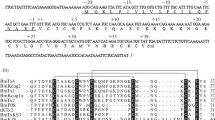Abstract.
Scorpions have survived successfully over millions of years without detectable changes in their morphology. Instead, they have developed an efficient alomonal machinery and a stinging device supporting their needs for prey and defense. They produce a large variety of polypeptidic toxins that bind and modulate ion channel conductance in excitable tissues. The binding site, mode of action, and chemical properties of many toxins have been studied extensively, but little is known about their genomic organization and diversity. Genes representing each of the major classes of Buthidae scorpion toxins, namely, ``long'' toxins, affecting sodium channels (alpha, depressant, and excitatory), and ``short'' toxins, affecting potassium and chloride channels, were isolated from a single scorpion segment and analyzed. Each toxin type was found to be encoded by a gene family. Regardless of toxin length, 3-D structure, and site of action, all genes contain A+T-rich introns that split, at a conserved location, an amino acid codon of the signal sequence. The introns vary in length and sequence but display identical boundaries, agree with the GT/AG splice junctions, and contain T-runs downstream of a putative branch point, 5′-TAAT-3′. Despite little sequence similarity among all toxin classes, the conserved gene organization, intron features, and common cysteine-stabilized α-helical (CSH) core connecting an α-helix to a three-stranded β-sheet suggest, that they all evolved from an ancestral common progenitor. Furthermore, the vast diversity found among genomic copies, cDNAs, and their protein products for each toxin suggests an extensive evolutionary process of the scorpion ``pharmaceutical factory,'' whose success is due, most likely, to the inherent permissiveness of the toxin exterior to structural alterations.
Similar content being viewed by others
Author information
Authors and Affiliations
Additional information
Received: 16 March 1998 / Accepted: 30 July 1998
Rights and permissions
About this article
Cite this article
Froy, O., Sagiv, T., Poreh, M. et al. Dynamic Diversification from a Putative Common Ancestor of Scorpion Toxins Affecting Sodium, Potassium, and Chloride Channels. J Mol Evol 48, 187–196 (1999). https://doi.org/10.1007/PL00006457
Published:
Issue Date:
DOI: https://doi.org/10.1007/PL00006457




